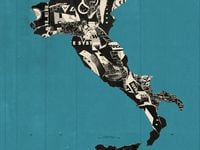Northern Italy is home to more oggetti di lussuria, or objects of lust, than anywhere in the world. This is especially evident in the valley that cradles the Po, Adda, and Ticino rivers, an area bordered by San Marino to the south, Milan and Torino to the west, and the Alps to the north. There, you’ll find an astounding array of notable Italian nameplates. Armani, Gucci, and Versace. Nordica, Vibram, and Campagnolo. Ferrari, Lamborghini, and Maserati. And, of course, Ducati, MV Agusta, Moto Guzzi, Bimota, Alpinestars, Dainese, Sidi, and Spidi. They all call this place home. If there’s a region on Earth responsible for more limbic-system secretions—or urgent “I gotta have that!” thoughts—in the human brain, it has yet to be discovered. In the words of Italian composer Giuseppe Verdi, “You may have the universe if I may have Italy.” The concentration of moto-oriented producers and amazing motorcycle history in or around northern Italy’s Po Valley should come as no surprise. The area has been an industrial powerhouse for decades, one that’s pushed Italy to the eighth best nominal GDP in the world. Italy’s economic history has had its ups and downs over the past 150 years. Alpine rivers powered early factories in the late 1880s, with engineering and shipbuilding taking hold in the early 1900s. World War I and the subsequent depression weakened Italy’s budding industrial infrastructure, and the relentless bombing during the Allied invasion of 1943 crushed it to rubble. In 1948, the Marshall Plan earmarked some $1.2 billion for Italy’s recovery—alongside an investment of $13 billion to western Europe overall. That’s more than $100 billion today. The money primed Italy’s industrial rebirth during the late ’50s and ’60s. Cheap labor and the Korean War’s hunger for Italian steel during the 1950s helped fuel Italy’s amazing growth. It was in this fertile environment that Ferrari, Gucci, Ducati, and Alpinestars flourished.
Of course, a vibrant economy, a factory, and lots of cheap help don't automatically make oggetti di lussuria. Those elements alone didn't create the beautiful yet brutal simplicity of Dr. Taglioni's Super Sport Ducatis or the handsome functionality of Sante Mazzarolo's metal-shin Alpinestars motocross boot. Nor did they craft the sensuous body shapes and alloy castings that combined to make up Massimo Tamburini's MV Agusta F4.
There’s something else at work here—something dramatic and personal. Something cultural that reaches deep into Italian history. To its art and sculpture, and the individual satisfaction that results from true hand craftsmanship.
“Italians make things, beautiful things, things people want to use, things that make them feel good,” says motojournalist and Italophile Alan Cathcart, who’s lived in Italy and speaks the language. “It’s in their blood; it’s an ethos. It’s a country where function must be matched by form.”
They get it. There’s something in their DNA that almost ensures a high level of design and aesthetic excellence, craftsmanship, and pride in their work.
Function matched by form. It’s an elegant combination and one not easily achieved in the design and engineering worlds. Perhaps the finest example is the work of the late Tamburini (1943–2014), whose efforts with Bimota in Rimini, Ducati in Bologna, and MV Agusta in Varese over the years still set the standard for the pinnacle motorcycle design. From the HB1, the first CB750-powered Bimota, to the Ducati Paso and 916, and, finally, the exquisite MV Agusta F4, Tamburini generated more moto lust over the years than any other motorcycle designer.
"Form and function cannot be separated," Tamburini said in an interview after the release of the F4. "A well-designed piece [that's] nice to look at must also surely be functional. The two things can and must exist together." Aside from exquisite shapes, Tamburini also pushed lightweight engineering years before the GSX-R750.
“I remember a meeting in Japan with Suzuki,” he said, “when an engineer asked me what I thought would be the bike of the future. I remember very clearly my answer: a 750 with the power of a 1000 and the weight of a 500. This was my view back in ’83, and today I still hold this view.”
That view was on full display with the Bimotas of the ’70s and ’80s, and despite their low production numbers, the lightweight and powerful machines affected everyone building sport motorcycles at the time. We have to wonder: Did Tamburini’s discussion with that engineer help advance the development of the ultra-light GSX-R750 of 1985? It’s entirely possible.
Italy's manufacturers find each other. Designers and artisans collect in clusters for convenience and economy. The Veneto region, north of Venice—and more specifically the boot-making towns of Montebelluna, Asolo, and Maser in the Alpine foothills—is a perfect example of this almost communal strength. Long an area specializing in hiking, mountain climbing, and ski boots, the region is home to many moto-specific manufacturers, including Alpinestars, Sidi, Gaerne, Dainese, and Spidi.
Alpinestars got its start in the early 1960s when Sante Mazzarolo began making outdoor footwear in Asolo. With motocross popularity spreading rapidly across Europe at the time, Mazzarolo made advanced and highly moto-specific boots. They quickly caught on after legendary motocrosser Roger DeCoster adopted them. Mazzarolo’s son Gabriele, who took over the company in 1993 and built it into an industry powerhouse, feels the emotional and historical pulls that have helped build and guide his company.
“There’s definitely something special about Italian design,” Mazzarolo told me recently. “This spirit may come from the fact that, for centuries, Italians have developed and passed on an understanding of design that peaked during the Renaissance. With rare exception, from that point forward, every visible element of society—whether decorative or functional—has been aesthetically updated and perfected.”
“Italians, I think, have always known how to combine products with experiences,” he added. “Fashion, footwear, fast cars, lifestyle, sports, and of course motorcycles. Motorcycles, specifically, are the culmination of all these things: Motorcycles are speed, freedom, experiences, and they are naturally intertwined with fashion—the look of a rider’s clothing and the safety aspect too. Even more crucial is that Italian engineers understand the aesthetic and emotional aspect as much as their design/styling counterparts. There is rarely a push-pull between engineering and design, and the idea that design is understood and appreciated by all is a huge part of what makes Italian design so great.”
Ducati CEO Claudio Domenicali echoes much of what Mazzarolo says. “Every Ducati,” he told us, “is a symbol of Italian culture, style, and genius. At Ducati, when we speak about ‘being Italian,’ we have two characteristics in mind—‘clean’ and ‘essential,’ meaning the motorcycle should only have what it needs [nothing superfluous], and ‘compactness,’ dimensionally and in overall impression. The ‘Italian way’ is not only art and taste but also industrial know-how that delivers reliable, beautiful products. This is why we have a long tradition of producing high-quality motorcycles in Italy.”
We’ve mentioned the original Ducati SuperSports and 916s, and MV’s F4, and the Alpinestars motocross boot. But how do you explain the classic Vespa scooters of the ’60s and ’70s? Or the stunningly sexy Laverda triples of the 1970s? Morini’s ’70s-spec V-twins were really funky. Remember Italjet? How about Mondial’s Count Boselli selling Soichiro Honda a genuine GP racebike in the late ’50s, ostensibly for Mr. Honda to study? What about Italy’s near-complete domination on the GP scene between ’49 and ’79, when Italian marques won nearly 70 world championship titles? Or the way Moto Guzzi knocked out the V7 even while state-owned—and obligated to focus on practical things like scooters? How did the Italians quickly pivot from near-total destruction after WWII to a dominant force in motorcycling—building machines that were the envy of the world?
Simply put, they can’t help themselves. Italians do things differently. They care a little differently. That does not mean Honda’s Tadao Baba, the father of the CBR900RR, and BMW’s Laszlo Peres, the mind behind the R80G/S, didn’t care. Italians simply add a bit of ground red pepper and Asiago to the recipe. They talk motorcycles with their hands. They are passionate in defeat and emotional in victory. There is strength and confidence no matter the challenge—learned without being taught, merely by soaking in the tradition and pedigree of a society that has built societies.
Being Italian seems to program in a certain pride and resilience that breeds belief. Hence the gall and moxie Italians showed when WWII ended. It’s character, blended with style. The flamboyance in design and devotion to craftsmanship has created marques known around the world for everything from stitching to exhaust note. Motorcycling, especially, has benefitted and to an extent that it’s impossible to imagine the two-wheel landscape without Italy













/cloudfront-us-east-1.images.arcpublishing.com/octane/KJPSWFKKDS3QAQKTJ3KRV6BROA.jpg)
/cloudfront-us-east-1.images.arcpublishing.com/octane/MUQLOVLL2ZDGFH25ILABNBXKTI.jpg)
/cloudfront-us-east-1.images.arcpublishing.com/octane/TNOU5DNE2BC57MFPMGN2EIDXAM.jpg)
/cloudfront-us-east-1.images.arcpublishing.com/octane/GTCXACQGJ5HAPDTGWUQKDEH44E.jpg)
/cloudfront-us-east-1.images.arcpublishing.com/octane/S35YGSEMEZB4BLTDJTSZPF4GLA.jpg)
/cloudfront-us-east-1.images.arcpublishing.com/octane/5UOT6HPX2JFMRJAX6EH45AR4MQ.jpg)
/cloudfront-us-east-1.images.arcpublishing.com/octane/OKWOJWAKP5EP3OACCRRWPCIX2Q.jpg)
/cloudfront-us-east-1.images.arcpublishing.com/octane/2WF3SCE3NFBQXLDNJM7KMXA45E.jpg)
/cloudfront-us-east-1.images.arcpublishing.com/octane/G4MG6OUCJNBSHIS2MVVOTPX65E.jpg)
/cloudfront-us-east-1.images.arcpublishing.com/octane/IIGGWFOTOJGB7DB6DGBXCCMTDY.jpg)
/cloudfront-us-east-1.images.arcpublishing.com/octane/QSTCM6AVEZA5JJBUXNIQ3DSOF4.jpg)
/cloudfront-us-east-1.images.arcpublishing.com/octane/U4I7G625B5DMLF2DVIJDFZVV6M.jpg)
/cloudfront-us-east-1.images.arcpublishing.com/octane/B6XD6LS6IVCQPIU6HXDJSM3FHY.jpg)
/cloudfront-us-east-1.images.arcpublishing.com/octane/ICL63FEDDRDTTMINYICCEYGMDA.jpg)
/cloudfront-us-east-1.images.arcpublishing.com/octane/FCGZHQXRBZFLBAPC5SDIQLVF4I.jpg)
/cloudfront-us-east-1.images.arcpublishing.com/octane/WNOB6LDOIFFHJKPSVIWDYUGOPM.jpg)

/cloudfront-us-east-1.images.arcpublishing.com/octane/X33NU3E525ECRHXLNUJN2FTRKI.jpg)
/cloudfront-us-east-1.images.arcpublishing.com/octane/6KKT5NNL2JAVBOXMZYS5ZO76YA.jpg)
/cloudfront-us-east-1.images.arcpublishing.com/octane/J5RKG5O455GMPGQRF2OG6LRT7A.jpg)
/cloudfront-us-east-1.images.arcpublishing.com/octane/GX2CIZKQVRH2TATDM26KFG2DAE.jpg)
/cloudfront-us-east-1.images.arcpublishing.com/octane/ZWIDYSAKQZHD5BHREMQILXJCGM.jpg)
/cloudfront-us-east-1.images.arcpublishing.com/octane/CYUHJZCTSJCH3MRAQEIKXK7SCQ.jpg)
/cloudfront-us-east-1.images.arcpublishing.com/octane/LKOFINY56FCXJCANJ5M7ZDQUBY.jpg)
/cloudfront-us-east-1.images.arcpublishing.com/octane/4NBPDACMWJH63JQYJVK3QRBDZI.jpg)